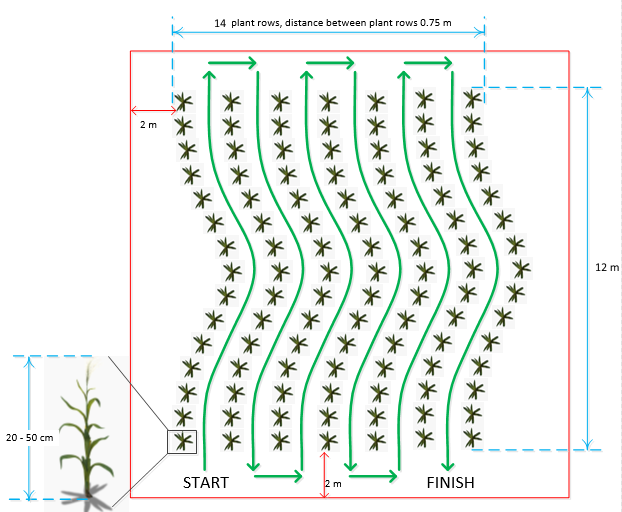General description
For this task, the robots are navigating autonomously through a maize field. Within three minutes, the robot has to navigate through curved (!) rows (picture 2 at the end of this text). The aim is to cover as much distance as possible. On the headland, the robot has to turn and return in the adjacent row. This task is all about accuracy, smoothness and speed of the navigation operation between the rows.
The starting is on the left side of the field (first turn is right) or on the right side (first turn is left). This is not a choice of the team but of the officials. Therefore, the robots should be able to perform for both options. A headland width of 2 meters free of obstacles (bare soil) will be available for turning operations. The headland will be indicated by a fence or ditch or similar (3D object).
Virtual Field Environment
Random stones are placed along the path to represent a realistic field scenario. The stones are not exceeding 25 mm from the average ground level. The stones may be small pebbles (diameter <25 mm) laid in the ground and large rocks that protrude (maximally 25 mm) from the ground. In other words, typical outdoor abilities as defined by machine ground clearance and to climb over small obstacles are required.
There will be no gaps in row entries as well as at the end of the rows. The ends of the rows may not be in the same line.
Rules for robots
Each robot has only one attempt. For starting, the robot is placed at the beginning of the first row without crossing the white line. The maximum available time for the run is 3 min.
Assessment
The distance travelled during task duration is measured. The final distance will be calculated including especially a bonus factor when the end of the field is reached in less time than 3 min. The final distance including a bonus factor is calculated as:
Sfinal [m] = Scorrected [m] * 3 [min] / tmeasured [min]
The corrected distance includes travelled distance and the penalty values. Travelled distance, penalty values and performance time are measured by the jury officials.
Crop plant damage by the robot will result in a penalty of 2% of total row length distance in meter per damaged plant. (This year example 10 x 5 m = 50 m max. distance, means a penalty of 1 m per damaged plant.)
The task completing teams will be ranked by the results of resulting total distance values. The best 3 teams will be rewarded.
Points for the overall winner will be given as described under Awards.


